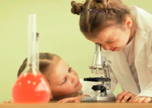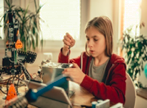Barrières voor meisjes bij het kiezen voor een STEM-richting.
- LienGeraets

Waar zijn al die vrouwelijke wetenschappers?
Elk jaar studeren er te weinig jongeren, en dan voornamelijk meisjes, af met een diploma binnen de exacte wetenschappen, toegepaste wetenschappen, ICT en techniek. De komende jaren zal dit voor problemen zorgen wanneer een groot deel technici, ingenieurs en wetenschappers op pensioen zullen gaan en vervangen moeten worden.
De ondervertegenwoordiging van meisjes in deze richtingen gaat ver terug in de tijd en de initiatieven die al genomen werden, blijken weinig efficiënt te zijn.
De grootste oorzaak hiervan is een diepgeworteld sociaal-cultureel en psychologisch probleem.
Kinderen groeien op met bepaalde genderverwachtingen. Meisjes leren voornamelijk om voor een gezin te zorgen en jongens om met hun handen te werken. Aan meisjes wordt vaak al van kinds af aan duidelijk gemaakt dat wetenschappen en techniek meer iets voor jongens is. Jongens krijgen zowel op school als in de vrije tijd meer de kans om vrij te experimenteren met materiaal waardoor het lijkt dat zij meer technisch ingesteld zijn.
Onder andere deze verschillen in genderverwachtingen zorgen voor een laag zelfbeeld van meisjes binnen STEM (Science, Technology, Engineering en Mathematics). Ook de leeromgeving (de school) is voor meisjes vaak een weinig stimulerende omgeving wat betreft STEM. Daarbovenop komt nog eens het gebrek aan vrouwelijke rolmodellen en een stereotiep beeld van mannen binnen STEM-beroepen. Meisjes zouden zich voor minder gaan afvragen of ze wel thuishoren in de wereld van wetenschap en techniek.
“Nothing in life is to be feared, it is only to be understood. Now is the time to understand more, so that we may fear less.”
Marie Curie


Oplossingen?
Uit onderzoek is gebleken dat wanneer jongeren in contact komen met succesvolle, vrouwelijke wetenschappers en wiskundigen, dit een positieve invloed heeft op de gender gerelateerde stereotypes. En hoe meer voorbeelden ze te zien krijgen, hoe meer ze dit als de ‘normale’ trend gaan bekijken.
Het aanbieden van STEM-programma’s geeft meer voeling met het werkveld, maar het is vooral door samen te werken met andere meisjes, dat hun zelfvertrouwen verhoogd wordt. Ze voelen zich veilig genoeg om fouten te maken en hiervan te leren. Ze leren om te gaan met feedback en verbeteren hun communicatievaardigheden.
Door naschoolse activiteiten zoals bijvoorbeeld Studio-T en Robocup junior worden onderzoeksmogelijkheden aangeboden die geen deel uitmaken van de gewone schooldag. Het is belangrijk dat de nadruk wordt gelegd op praktische, realistische ervaringen.
“The more one does, the more one can do.”
Amelia Earhart

Op zoek naar de oorzaak
Welke rol hebben de ouders bij de keuze die gemaakt wordt om, als meisje, al dan niet voor een STEM-richting te kiezen in het secundair onderwijs? We onderzochten onder andere de invloed van het aangeboden speelgoed, of de meisjes een genderneutrale opvoeding kregen, of zij al dan niet stereotiepe voorbeelden te zien kregen in de verdeling van het huishouden en het beroep van de ouders,….
Ook leerkrachten spelen uiteraard een belangrijke rol bij het aanwakkeren van de interesse in wetenschap en techniek. Daarom onderzochten we ook wat meisjes nodig hebben om een STEM-les als interessant of motiverend te ervaren.
Door zowel ouders als kinderen te gaan interviewen, hebben we een ruimer en completer beeld gekregen van de oorzaken waarom meisjes al dan niet voor een STEM-richting kiezen.
“Science & everyday life cannot & should not be separated.”
Rosalind Franklin
Resultaten
Meisjes die een vader hebben met een hoger opleidingsniveau (bachelor/ master) zullen minder snel kiezen voor een STEM-richting. De opleiding van de vader primeert op het opleidingsniveau van de moeder. Toch blijkt het beroep van de vader geen groot verschil uit te maken bij de studiekeuze van de dochter. Het merendeel van de meisjes die kiezen voor een STEM-richting hebben een moeder met een STEM-beroep. Hier komt dan weer het belang van het vrouwelijk rolmodel naar voren.
Meisjes die opgroeien met broers komen automatisch meer in aanraking met zowel ‘meisjes-’ als ‘jongensspeelgoed’. Hun ouders houden meer rekening met een genderbewuste opvoeding en willen dat hun kinderen hun eigen keuzes maken, die niet geslachtsgebonden zijn. Je zou denken dat dit een goede voedingsbodem is voor het kweken van een interesse in wetenschap en techniek maar dit blijkt niet zo te zijn. Het zijn vooral deze meisjes, die een genderneutrale opvoeding kregen, die net niet kiezen voor een STEM-richting.
Toch blijkt het aanbieden van technisch speelgoed, wetenschaps- en proefdozen en het volgen van buitenschoolse techniekworkshops wel een positieve invloed te hebben op de STEM-studiekeuze van meisjes.
Het is opvallend dat bij de meisjes die kiezen voor een STEM-richting de traditionele man/vrouw-taakverdeling in hun gezin wordt doorbroken. Dit zou kunnen betekenen dat deze meisjes anders kijken naar genderverwachtingen en hierdoor minder geremd worden in hun keuze voor wetenschappen en techniek.
Het merendeel van de geïnterviewde meisjes gaf aan niet zelf hun studiekeuze te mogen maken. Hun ouders of de schoolomgeving maken die beslissing voor hen. Hierdoor weten we niet waar hun interesses liggen, en of ze in andere omstandigheden wel voor een STEM-richting zouden kiezen. Als we de geïnterviewde meisjes vroegen wat ze zouden kiezen van studierichting indien ze wel volledig autonoom mochten kiezen, dan kiezen ze voornamelijk voor een STEM-richting.
Bij de STEM-workshops blijkt het aangeboden thema en eindproduct van belang te zijn voor de interesse van de meisjes. Het maken van pralines bijvoorbeeld genoot meer voorkeur dan het lanceren van een raket. Dit zou er op kunnen wijzen dat meisjes meer interesse hebben in de voedingssector en minder in de harde techniek. Enkele meisjes gaven ook spontaan aan dat het samenwerken met andere meisjes een meerwaarde heeft.
Wat heel duidelijk naar voren kwam is dat een actieve betrokkenheid, dus zelf actief iets creëren, van groot belang is om hun interesse in de workshops te verhogen.
Kinderen kunnen zich vaak maar weinig voorstellen bij de begrippen “wetenschap” en “techniek”. Hierbij is de rol van de leerkracht van groot belang. Wanneer de leerkracht over de juiste kennis en vaardigheden beschikt en ook voldoende zelfvertrouwen heeft om met STEM aan de slag te gaan in de klas, zullen meer leerlingen interesse ontwikkelen in wetenschappen en techniek.
Om met de woorden van Dr. Amy Farrah Fowler en Dr. Bernadette (The Big Bang Theory S6: Afl 18) af te sluiten: “De wetenschap heeft meer vrouwen nodig. Maar al vanop een jonge leeftijd worden wij meisjes aangemoedigd om meer aandacht aan ons uiterlijk te besteden dan aan de kracht van ons brein. Elk van jullie heeft de mogelijkheid om te worden wat je wilt.”
Bibliografie
Agoria Vlaanderen (2006) – “Skills for the future. Competentieagenda 2015. De Technologische industrie in Vlaanderen”
Alexander, G. M., & Hines, M. (2002). Sex differences in response to children's toys in nonhuman primates (Cercopithecus aethiops sabaeus). Evolution and Human Behavior, 467-479. doi: 10.1016/S1090-51380200107-1
Ames, C. (1992). Classrooms: Goals, structures, and student motivation. Journal of Educational Psychology, 84, 261-271.
Anderson, L., & Gilbride, K. (2003). Bringing engineering to K-12 classrooms: Initiatives and results. Proceedings of the 2003 American Society for Engineering Education Annual Conference.
Ardies, J. (2015). Student’s attitudes towards technology. A cross-sectional and longitudinal study in secondary education. (doctoraatsstudie). Antwerpen, België: Universiteit Antwerpen.
Auyeung, B., Baron-Cohen, S., Ashwin, E., Knickmeyer, R., Taylor, K., Hackett, G., & Hines, M. (2009). Fetal testosterone predicts sexually differentiated childhood behavior in girls and in boys. Psychological Science, 20, 144- 148. doi: 10.1111/j.1467-9280.2009.02279.x
Bame, E., Dugger, W., de Vries, M. & McBee, J. (1993). Pupils' attitudes toward technology - PATT-USA. Journal of Technology Studies, 19, 40-48.
Kind, P. M., Jones, K., & Barmby, P. (2007). Developing attitudes towards science measures. InternationalJournalofScienceEducation,29,871–893.doi:10.1080/09500690600909091.
Bennett, J., Rollnick, M., Green, G., & White, M. (2001). The development and use of an instrument toassessstudents’attitudetothestudyofchemistry.InternationalJournalofScienceEducation,23,833–845.
Baudelot C. & Mossuz-Laveau J. Dir. (2004).Quand les femmes s’en meˆlent. Genre et pouvoir pp. 324– 347. Paris: La martinie´re.
Beede, D. N., Julian, T. A., Langdon, D., McKittrick, G., Khan, B., & Doms, M. E. (2011). Women in STEM: A gender gap to innovation. Economics and Statistics Administration Issue Brief, p.04-11.
Blakemore, J. E. O., & Centers, R. E. (2005). Characteristics of boys' and girls' toys. Sex Roles, 53 9-10, 619-633. doi: 10.1007/s11199-005-7729-0
Blickenstaff, J. C. (2005). Women and science careers: Leaky pipeline or genderfilter? Gender and Education, 17, 369–386.
Blüchel, M., Lehmann, J., Kellner, J., & Jansen, P. (2013). The improvement in mental rotation performance in primary school-aged children after a two-week motor-training. Educational Psychology, 33, 75-86. doi: 10.1080/01443410.2012.707612
Boakes, N. J. (2009). Origami Instruction in the Middle School Mathematics Classroom: Its Impact on Spatial Visualization and Geometry Knowledge of Students. RMLE Online: Research in Middle Level Education, 32, 1-12.
Bøe, M. V., Henriksen, E. K., Lyons, T. & Schreiner, C. (2011). Participation in science and technology: Young people’s achievement-related choices in latemodern societies. Studies in Science Education, 47, 37–72.
Borko, H. (2004). Professional development and teacher learning: Mapping the terrain. Educational Researcher,33,3–15.doi:10.3102/0013189033008003.
Brotman, J. S. & Moore, F. M. (2008). Girls and Science: A review of four themes in the science education literature. Journal of Research of Science Teaching, 45, 971–1002.
Buchmann, C., DiPrete, T. A., & McDaniel, A. (2008). Gender inequalities in education. Annu. Rev. Sociol, 34, 319-337.
Buck, G. A., Leslie-Pelecky, D., & Kirby, S. K. (2002). Bringing female scientists into the elementary classroom: Confronting the strength of elementary students’ stereotypical images of scientists. Journal of Elementary Science Education, 14, 1-9.
Burkham DT (1997) Gender and science learning early in high school: Subject matter and laboratory experiences. American Educational Research Journal 34:297–331
Calabrese, L., & Marucci, F. S. (2006). The influence of expertise level on the visuospatial ability: differences between experts and novices in imagery and drawing abilities. Cognitive Processing, 7, 118-120. doi: 10.1007/s10339- 006-0094-2
Caldera, Y. M., Mc Culp, A. D., O'Brien, M., Truglio, R. T., Alvarez, M., & Huston, A. C. (1999). Children's play preferences, construction play with blocks, and visual-spatial skills: Are they related? International Journal of Behavioral Development, 23, 855-872.
Caplan, P. J., & Caplan, J. B. (1994). Thinking critically about research on sex and gender. New York: Harper Collins.
Ceci, S. J. & Williams, W.M. (2010). Sex differences in math-intensive fields. Current Directions in Psychological Science, 0963721410383241.
Chaponnie`re, M. (2006). La mixite´ scolaire: de´bat d’hier et d’aujourd’hui. In A. Dafflon Novelle Dir, Filles-garc¸ons: socialisation diffe´rencie´e pp. 127–144. Grenoble: PUG.
Chatoney, M., & Andreucci, C. (2009). How study aids influence learning and motivation for girls in technology education. International Journal of Technology and Design Education, 19, 393-402.
Cheng, Albert, Katherine Koptic, and Gema Zamorro. 2017. “Can Parents’ Growth Mindset and Role Modelling Address STEM Gender Gaps?” Department of Education Reform, University of Arkansas, EDRE Working Paper 2017-07.
Cheryan, S., Plaut, V. C., Davies, P. G., & Steele, C. M. (2009). Ambient belonging: How stereotypical cues impact gender participation in computer science. Journal of Personality and Social Psychology, 97, 1045-1060.
Chesky, N., & Goldstein, R. A. (2018). Packaging Girls for STEM or STEM for Girls? A critique on the perceived crisis of increasing female representation in STEM education. Critical education , 9, 98–126. Geraadpleegd van https://ices.library.ubc.ca/index.php/criticaled/article/view/186415
Cobern,W.W.,&Loving,C.C.(2002).Investigationofpreserviceelementaryteachers’thinkingabout science.JournalofResearchinScienceTeaching,39,1016–1031.doi:10.1002/tea.10052.
Connellan, J., Baron-Cohen, S., Wheelwright, S., Batki, A., & Ahluwalia, J. (2000). Sex differences in human neonatal social perception. Infant behavior and Development, 23(1), 113-118.
Cooper, R., & Heaverlo, C. (2013). Problem Solving and Creativity and Design: What Influence Do They Have on Girls' Interest in STEM Subject Areas?. American Journal of Engineering Education, 4(1), 27-38.
Cunningham, B. C., Hoyer, K. M., & Sparks, D. (2015). Gender Differences in Science, Technology, Engineering, and Mathematics (STEM) Interest, Credits Earned, and NAEP Performance in the 12th Grade. Stats in Brief. NCES 2015-075. National Center for Education Statistics.
Dasgupta, N., & Stout, J. G. (2014). Girls and women in science, technology, engineering, and mathematics: STEMing the tide and broadening participation in STEM careers. Policy Insights from the Behavioral and Brain Sciences, 1(1), 21-29.
David, M. et al. (2003) – “Gender Issues in Parental Involvement in Student Choice of Higher education.” Gender and Education, 15 (1) 21-37.
De Klerk Wolters, F. (1989). A PATT study among 10 to 12-year-old students in the Netherlands.
Dehaan, R.L. (2011). Teaching creative science thinking. Science, 334, 1499-1500.
Delfos, M. F. (2018). De schoonheid van het verschil: waarom mannen en vrouwen verschillend én hetzelfde zijn. SWP Amsterdam.
De Martelaere D. en Van den Berghe W., Kiezen voor STEM, VRWI, 2012, www.vrwi.be/publicaties/rapport-kiezen-voor-stem.
Derksen, L. M. (2015). Talent viewer: evaluation of a project aimed at breaking down (gender) stereotypes about STEM and STEM-talents in primary schools in the Netherlands. International Journal of Gender, Science and Technology, 8(1), 144-156.
Desimone,L.M.(2009).Improvingimpactstudiesofteachers’professionaldevelopment:towardbetter conceptualizationsandmeasures.EducationalResearcher,38,181–199.doi:10.3102/001318908331140.
Durik, A. M., & Eccles, J. S. (2006). Classroom activities in math and reading in early, middle, and late elementary school. Journal of Classroom Interaction, 41, 33-41.
Duru-Bellat, M. (2005). L’e´cole des filles, quelle formation pour quels roˆles sociaux? Paris: l’Harmatan.
Duru-Eccles, J. S., & Jacobs, J. E. (1986). Social forces shape math attitudes and performance. Signs, 11, 367–380.
Eccles, Jacquelynne S., and Janis E. Jacobs. 1986. “Social Forces Shape Math Attitudes and Performance.” Signs: Journal of Women in Culture and Society 11:367–380. doi:10.1086/494229.
Eccles, Jacquelynne S., Janis E. Jacobs, and Rena D. Harold. 1990. “Gender Role Stereotypes, Expectancy Effects, and Parents’ Socialization of Gender Differences.” Journal of Social Issues 46(2):183–201. doi:10.1111/j.1540-4560.1990.tb01929.x.
Eccles, J.S. (2007). Where are all the women? Gender differences in participation in physical science and engineering. In S. J. Ceci & W. M. Williams, Why Aren’t More Women in Science? Top Researchers Debate the Evidence (pp. 199–210). Washington, DC: American Psychological Association.
Eccles, J.S., Barber, B. & Jozefowicz, D. (1999). Linking Gender to Educational, Occupational, and Recreational Choices: Applying the Eccles et al. Model of Achievement-Related Choices. Washington, DC: American Psychological Association.
Eccles, J. S., Jacobs, J. E., & Harold, R. D. (1990). Gender role stereotypes, expectancy effects, and parents’ socialization of gender differences. Journal of Social Issues, 46, 183-201.
Ferrara, K., Hirsh-Pasek, K., Newcombe, N. S., Golinkoff, R. M., & Lam, W. S. (2011). Block talk: Spatial language during block play. Mind, Brain, and Education, 5, 143-151. doi: 10.1111/j.1751-228X.2011.01122.x
Frick, A., Daum, M. M., Walser, S., & Mast, F. W. (2009). Motor processes in children's mental rotation. Journal of Cognition and Development, 10, 18-40. doi: 10.1080/15248370902966719
Fryer, Roland G. Jr., and Steven D. Levitt. 2010. "An Empirical Analysis of the Gender Gap in Mathematics." American Economic Journal: Applied Economics 2:210–240.
Galdi, S., Cadinu, M. & Tomasetto, C. (2014). The roots of stereotype threat: When automatic associations disrupt girls' math performance. Child Development, 85, 250–263.
Gill, D., & Kamphoff, C. (2010). Gender in Sport and Exercise Psychology. In J. C. Chrisler & D. R. McCreary, Handbook of Gender Research in Psychology pp. 563-585: Springer New York.
Goodrum, D., Hackling, M., & Rennie, L.. (2001). The status and quality of teaching and learning of science in Australian schools A research report for the Department of Education, Training and Youth Affairs.Canberra,Australia.
Halari, R., Sharma, T., Hines, M., Andrew, C., Simmons, A., & Kumari, V. (2006). Comparable fMRI activity with differential behavioural performance on mental rotation and overt verbal fluency tasks in healthy men and women. Experimental brain research, 169, 1-14. doi: 10.1007/s00221-005-0118-7
Halpern D, Aronson J, Reimer N, Simpkins S, Star J, Wentzel K (2007) Encouraging girls in math and science. National Center for Education Research, Institute of Education Sciences, U.S. Department of Education, Washington D.C.
Haney, J. J., Czerniak, C. M., & Lumpe, A. T. (1996). Teacher beliefs and intentions regarding the implementationofscience educationreformstrands.JournalofResearch inScience Teaching,33,971–993. doi:10.1002/SICI1098-273619961133:9<971::AID-TEA2>3.0.CO;2-S.
Haney, J. J., Lumpe, A. T., Czerniak, C. M., &Egan, V. (2002). From beliefs toactions: The beliefs and actionsofteachersimplementingchange.JournalofScienceTeacherEducation,13,171–187.doi:10.1023/ A:1016565016116.
Harlen, W., & Holroyd, C. (1997). Primary teachers’ understanding of concepts of science: Impact on confidence and teaching. International Journal of Science Education, 19, 93–105. doi: 10.1080/ 0950069970190107.
Hartung, P. J., Porfeli, E. J. & Vondracek, F.W. (2005). Child vocational development: A review and reconsideration. Journal of Vocational Behavior, 66, 385–419.
Hassett, J. M., Siebert, E. R., & Wallen, K. (2008). Sex differences in rhesus monkey toy preferences parallel those of children. Hormones and Behavior, 54, 359-364. doi: 10.1016/j.yhbeh.2008.03.008
Hauttekeete, L. (2007) – “Are you ready for the future? De visie van jongeren op technologie, industrie en werk.” Onderzoeksgroep MICT UGent, Agoria Vlaanderen
Hines, M. (2010). Sex-related variation in human behavior and the brain. Trends in Cognitive Sciences, 14, 448-456. doi: 10.1016/j.tics.2010.07.005
Hines, M. (2015b). Gendered development. In R. M. Lerner & M. E. Lamb Eds., Handbook of Child Development and Developmental Science 7th ed. Hoboken, NJ: Wiley.
Jacobs, J.E. et al. (2006) – “Enduring Links: Parents’ Expectations and their Young Adult Children’s Gendertyped Occupational Choice.” Educational Research and Evaluation 12 (4) 395-407.
Jansen, P., Lange, L., & Heil, M. (2011). The influence of juggling on mental rotation performance in children. Biomedical Human Kinetics, 3, 18-22. doi: 10.2478/v10101-011-0005-6
Jansen, P., Titze, C., & Heil, M. (2009). The influence of juggling on mental rotation performance. International Journal of Sport Psychology, 40, 351-359.
Jarvis, T., & Pell, A. (2004). Primary teachers’ changing attitudes and cognition during a two-year science inservice program and their effect on pupils. International Journal of Science Education, 26, 1787– 1811.doi:10.1080/0950069042000243763.
Jirout, J. J., & Newcombe, N. S. (2014). Mazes and maps: Can young children find their way? Mind, Brain, and Education, 8, 89-96. doi: 10.1111/mbe.12048
Jirout, J. J., & Newcombe, N. S. (2015). Building blocks for developing spatial skills Evidence from a large, representative US sample. Psychological Science, 26, 302-310. doi: 10.1177/0956797614563338
Johnson, G. M., & Bratt, S. E. (2009). Technology education students: e‐Tutors for school children. British Journal of Educational Technology, 40(1), 32-41.
Khan, S., & Ginther, D. (2017). Women and STEM . National Bureau of Economic Research .
Kirk, M., & Zander, C. (2002). Bridging the digital divide by co-creating a collaborative computer science classroom. Journal of Computing Sciences in Colleges, 18, 117–125.
Konrad, A. M., Ritchie, J. E., Lieb, P., & Corrigall, E. (2000). Sex differences and similarities in job attribute preferences: A meta-analysis. Psychological Bulletin, 126, 593-641.
Kulturel-Konak, S., D'Allegro, M. L., & Dickinson, S. (2011). Review of gender differences in learning styles: Suggestions for stem education. Contemporary Issues in Education Research, 4(3), 9-18.
Langen, A.V. et al. (2006) – “Sex-related differences in the determinants and process of science and mathematics choice in pre-university education.” International Journal of Science Education 28 (1), 71- 94
Leaper, C. (2005). Parenting girls and boys. In M. H. Bornstein Ed., Handbook of parenting Vol. 1, pp. 189-225. Mahwah, NJ: Lawrence Erlbaum.
Lloyd, B., & Smith, C. (1986). The effects of age and gender on social behaviour in very young children. British Journal of Social Psychology, 25, 33-41.
Maloney, Erin A., Gerardo Ramirez, Elizabeth A. Gunderson, Susan C. Levine, and Sian L Beilock. (2015). “Intergenerational effects of parents’ math anxiety on children’s math achievement and anxiety.” Psychological Science 26:1480–1488. doi:10.1177/0956797615592630.
Mammes, I. (2004). Promoting Girls' Interest in Technology through Technology Education: A Research Study. International Journal of Technolgy and Design Education, 14(2), 89-100.
Miller, D. I., Eagly, A. H. & Linn, M. C. (2014). Women’s representation in science predicts national gender-science stereotypes: Evidence from 66 nations. Journal of Educational Psychology, http://dx.doi.org/10.1037/edu0000005
Moreau, D., Clerc, J., Mansy-Dannay, A., & Guerrien, A. (2015). Enhancing spatial ability through sport practice. Journal of Individual Differences, 33, 83-88. doi: 10.1027/1614-0001/a000075
Mosatche, H. S., Matloff-Nieves, S., Kekelis, L., & Lawner, E. K. (2013). Effective STEM programs for adolescent girls: Three approaches and many lessons learned. Afterschool matters, 17, 17-25.
Mosconi, N. (1994). Femmes et savoir. La socie´te´, l’e´cole et la division sexuelle des savoirs. Paris: l’Harmattan.
Murphy, M., Steele, C. M., & Gross, J. (2007). Signaling threat: How situational cues affect women in math, science, and engineering settings. Psychological Science, 18, 879-885.
Naizer, G., Hawthorne, M. J., & Henley, T. B. (2014). Narrowing the Gender Gap: Enduring Changes in Middle School Students' Attitude Toward Math, Science and Technology. Journal of STEM Education: Innovations & Research, 15.
Newcombe, N. S., & Frick, A. (2010). Early education for spatial intelligence: Why, what, and how. Mind, Brain, and Education, 4(3), 102-111. doi: 10.1111/j.1751-228X.2010.01089.x
Nollenberger, Natalia, Nuria Rodriguez-Planas, and Almudena Sevilla. 2016. "The Math Gender Gap: The Role of Culture." American Economic Review 106:257–61. doi:10.1257/aer.p20161121.
Nosek, Brian A., Frederick L. Smyth, N. Sriram, Nicole M. Lindner, Thierry Devos, Alfonso Ayala, Yoav Bar-Anan, et al. (2009). “National differences in gender-science stereotypes predict national sex differences in science and math achievement.” Proceedings of the National Academy of Science 106:10593–97.
Nye, B., Konstantopoulos, S., & Hedges, L. V. (2004). How large are teacher effects?. Educational EvaluationandPolicyAnalysis,26,327–257.doi:10.3102/01623737026003237.
OECD (2006). Evolution of student interest in science and technology studies – policy report. Global Science Forum: OECD.
Osborne, J. & Dillon, J. (2008). Science Education in Europe: Critical Reflections. London: The Nuffield Foundation.
Osborne, J., Simon, S., & Collins, S. (2003). Attitudes towards science: A review of the literature and its implications. International Journal of Science Education, 25, 1049–1079. doi: 10.1080/ 0950069032000032199.
Otto, P. B. (1991). One sex one science. School Science and Mathematics, 91, 367-372.
Piaget, J. (1951). Play, Dreams and Imitation in Childhood. C. Gattegno & F. M. Hodgson, Trans.. New York: Routledge and Kegan Paul Ltd.
Piaget, J., (1972). The childs’ conception of the world. Totowa N.J.: Littlefield Adams.
Pietsch, S., & Jansen, P. (2012). The relationship between coordination skill and mental rotation ability. In C. Stachniss, S. K. & D. H. Uttal (Eds.), Spatial Cognition VIII (pp. 173-181). Kloster Seeon, Germany: Springer.
Pope, Devin G., and Justin R. Sydnor. 2010. “Geographic Variation in the Gender Differences in Test Scores.” Journal of Economic Perspectives 24:95–108.
Reilly, D., Neumann, D. L., & Andrews, G. (2016). Gender Differences in Spatial Ability: Implications for STEM Education and Approaches to Reducing the Gender Gap for Parents and Educators. Research Gate.
Richter, W., Somorjai, R., Summers, R., Jarmasz, M., Menon, R. S., Gati, J. S., . . . Kim, S. (2000). Motor area activity during mental rotation studied by timeresolved single-trial fMRI. Cognitive Neuroscience, Journal of, 12, 310- 320.
Robine, F. (2006). Pourquoi les filles sont l’avenir de la science … .Bulletin de l’Union des professeurs de physique et de chimie, 100, 421–436.
Rosenwald, F. (2006). Filles et garc¸ons dans le syste`me e´ducatif depuis vingt ans. In Donne´es sociales La socie´te´ franc¸aise, Education, formation Vol. 2, pp 87–93.
Sadler, P. M., Sonnert, G., Hazari, Z., & Tai, R. (2012). Stability and volatility of STEM career interest in high school: A gender study. Science education, 96, 411-427.
Short, D. (2012). Teaching scientific concepts using a virtual world: Minecraft. Teaching Science, 58, 55-58.
Shusterman, A., Ah Lee, S., & Spelke, E. S. (2008). Young children's spontaneous use of geometry in maps. Developmental Science, 11, F1-F7. doi: 10.1111/j.1467-7687.2007.00670.
Sjøberg S. en Schreiner C.,(2010), The ROSE project. An overview and key findings, Oslo, http://roseproject.no.
Spence, I., & Feng, J. (2010). Video games and spatial cognition. Review of General Psychology, 14, 92-104. doi: 10.1037/a0019491
Stannard, L., Wolfgang, C. H., Jones, I., & Phelps, P. (2001). A longitudinal study of the predictive relations among construction play and mathematical achievement. Early Child Development and Care, 167, 115-125. doi: 10.1080/0300443011670110
Stout, J. G., Dasgupta, N., Hunsinger, M., & McManus, M. A. (2011). STEMing the tide: Using ingroup experts to inoculate women’s self-concept in science, technology, engineering, and mathematics (STEM). Journal of Personality and Social Psychology, 100, 255-270.
Subrahmanyan L, Bozonie H (1996) Gender equity in middle school science teaching: Being ‘‘equitable ‘‘should be the goal. Middle school Journal 27:3–10
Taylor, H. A., & Hutton, A. (2013). Think3d!: Training Spatial Thinking Fundamental to STEM Education. Cognition and Instruction, 31, 434-455.
Terlecki, M. S., Brown, J., Harner-Steciw, L., Irvin-Hannum, J., Marchetto-Ryan, N., Ruhl, L., & Wiggins, J. (2011). Sex differences and similarities in video game experience, preferences, and self-efficacy: Implications for the gaming industry. Current Psychology, 30, 22-33. doi: 10.1007/s12144-010-9095-5
Tyler-Wood T (1993) Educational opportunities for gifted students in Georgia. In: Presentation to the national association of gifted children, Atlanta, GA
Tyler-Wood, T., Ellison, A., Lim, O., & Periathiruvadi, S. (2012). Bringing up girls in science BUGS: The effectiveness of an afterschool environmental science program for increasing female students’ interest in science careers. Journal of Science Education and Technology, 21, 46-55.
Universiteit van Vlaanderen . (2019). Moeten we meisjes verplichten om een STEM-richting te volgen? [Videobestand]. Geraadpleegd van https://www.universiteitvanvlaanderen.be/college/moeten-we-meisjes-verp…
van Aalderen-Smeets, S. I., & Walma van der Molen, J. H. (2013). Measuring primary teachers’ attitudes toward teaching science: Development of the Dimensions of Attitude towards Science DAS instrument.InternationalJournalofScienceEducation,35,577–600.doi:10.1080/09500693.2012.755576
van Aalderen‐Smeets, S. I., & Walma van der Molen, J. H. (2015). Improving primary teachers’ attitudes toward science by attitude‐focused professional development. Journal of research in science teaching, 52(5), 710-734.
Van Aerschot, M. et al. (2003) – “Gezocht: ingenieur (m/v). Een onderzoek naar studiekeuze vanuit genderperspectief.” Steunpunt Gelijkekansenbeleid UA-LUC, 84 p
Van den Berghe, W., & De Martelaere, D. (2012). De invloed van ouders en familie. Kiezen voor STEM. De keuze van jongeren voor technische en wetenschappelijke studies., 122–123.
Van Driel, J. H., Beijaard, D., & Verloop, N. (2001). Professional development and reform in science education:Theroleofteachers’practicalknowledge.JournalofResearchinScienceTeaching,38,137–158. doi:10.1002/1098-273620010238:2<137::AID-TEA1001>3.0.CO;2-U.a
Veretennicoff, I., & Vandewalle, J. (2015). De STEM-leerkracht. De STEM-problematiek, 6.
VHTO (2008). Genderkennis.doc. Platform Bèta Techniek, Sprint Programma: VHTO.
Vilhjalmsson, R., & Kristjansdottir, G. (2003). Gender differences in physical activity in older children and adolescents: the central role of organized sport. Social science & medicine, 562, 363-374. doi: 10.1016/S0277-9536(02)00042-4
Vlaanderen . (z.d.). België haalt 32ste plaats in Global Gender Gap Index. Geraadpleegd op 10 oktober 2019, van https://do.vlaanderen.be/belgi%C3%AB-haalt-32ste-plaats-in-global-gende…
Vosmeer, M. S. (2010). Videogames en gender : over spelende meiden, sexy avatars en huiselijkheid op het scherm.
Wach, M. (1992). Projets et repre´sentations des e´tudes et des professions des e´le`ves de troisie`me et de terminale en 1992. In L’Orientation scolaire et professionnelle Vol. 21, 3, pp. 297–339.
Wang, M.-T. (2012). Educational and career interests in math: A longitudinal examination of the links between classroom environment, motivational beliefs, and interests. Develop-mental Psychology, 48, 1643-1657.
Watt, H. M. (2006). The role of motivation in gendered educational and occupational trajectories related to maths. Educational Research and Evaluation, 12(4), 305–322.
Weber, K. (2012). Gender Differences in Interest, Perceived Personal Capacity, and Participation in STEM-Related Activities. Journal of technology education, 24(1), 18-33.
Xie, Yu, and Kimberlee A. Schauman. 2003. Women in science: Career processes and outcomes. Cambridge: Harvard University Press.
Xu, Y. J. (2008). Gender disparity in STEM disciplines: A study of faculty attrition and turnover intentions. Research in Higher Education, 49(7), 607-624.
Zirkel, S. (2002). Is there a place for me? Role models and academic identity among white students and students of color. Teachers College Record, 104, 357–376.










